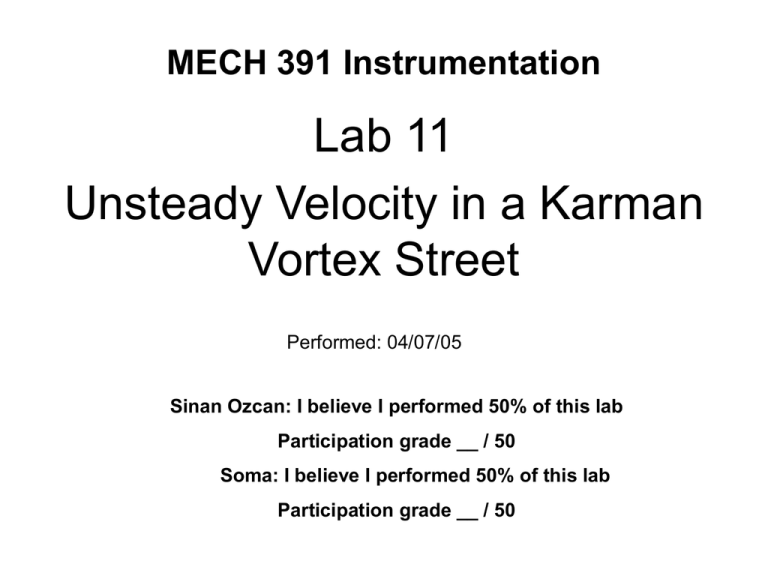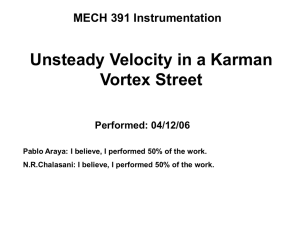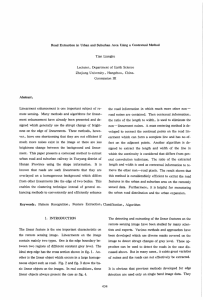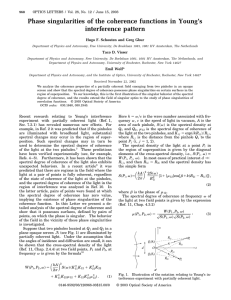
MECH 391 Instrumentation
Lab 11
Unsteady Velocity in a Karman
Vortex Street
Performed: 04/07/05
Sinan Ozcan: I believe I performed 50% of this lab
Participation grade __ / 50
Soma: I believe I performed 50% of this lab
Participation grade __ / 50
ABSTRACT
• The objective of this lab was to calibrate a hot
film anemometer using pitot probe and use it to
measure the unsteady speed and natural
frequency in a Karman Vortex Street.
• The dominant frequency in the unsteady wake
was measured for a range of wind speeds
• The Strouhal number (dimensionless
frequency) was consistently one half the
predicted value for the full Reynolds number
range investigated.
Table 1 Air Properties and Cylinder
Diameter
TR
0
C
23
PR
mbar
860
D
inch
0.25
m
2
N-s/m
1.82E-05
• Air viscosity from A.J. Wheeler and A.R. Ganji,
Introduction to Engineering Experimentation, 2nd Edition,
Pearson Prentice Hall, 2004, p. 430.
Table 2 Calibration Data
Blower
Position
IG
IP
VHF
PG
PP
PABS
Off
350
220
90
90 (cover)
220 (cover)
350 (cover)
Off
mA
4.00
6.25
5.69
4.71
4.19
4.40
4.54
4.00
mA
4.00
16.55
13.61
7.92
5.04
6.14
7.06
4.00
volt
2.267
4.53
4.39
4.06
3.65
3.87
3.97
2.271
Pa
0
1402
1053
442
118
249
336
0
Pa
0
586
449
183
49
100
143
0
kPa
86.0
87.4
87.1
86.4
86.1
86.2
86.3
86.0
r
3
kg/m
1.01
1.03
1.02
1.02
1.01
1.02
1.02
1.01
U
m/s
0.00
33.76
29.60
18.97
9.79
14.03
16.77
0.00
U0.5
0.5
(m/s)
0.00
5.81
5.44
4.36
3.13
3.75
4.10
0.00
• The initial and final no-wind hot film
voltage readings are close but not the
same
2
VHF
2
volt
5.14
20.52
19.27
16.48
13.32
14.98
15.76
5.16
Figure 1 Hot Film System Calibration
25
VHF2 [volt2]
20
15
10
VHF2 = 2.6181U1/2 + 5.1314
5
0
0
1
2
3
4
5
6
U0.5 [m/s]0.5
• The fit equation VHF2 = aU0.5+b appears to be appropriate for
these data
• The dimensional parameters are a= 2.6181 volts2s1/2/m1/2 and
b = 5.1314 volts2
Table 3 Karmon Frequency and
Incoming Wind Speed
f
hz
840
405
687
336
448
244
U
m/s
30.11
14.53
24.8
12.03
16.16
8.32
Re
[1]
10610
5120.2
8739.3
4239.3
5694.6
2931.9
St
[1]
0.1772
0.177
0.1759
0.1774
0.176
0.1862
Fig. 2 Spectral Content in Wake for Highest
Wind Speed
0.7
0.6
urms [m/s]
0.5
0.4
0.3
0.2
0.1
0
0
500
1000
1500
2000
2500
3000
f [hz]
• Largest spectral content is at 834 hz.
• Secondary peak are also observed.
Fig. 3 Measured Speed vs. Time
for Highest Wind Speed
70
60
u [m/s]
50
40
30
20
10
0
0
0.001
0.002
0.003
t [sec]
0.004
0.005
0.006
• 5 large peaks in 0.006 sec corresponds to
frequency 833 hz, in agreement with the most
energetic frequency in Fig. 2.
Figure 4 Stroughal versus Reynolds
0.25
Reference Value St = 0.20 to 0.21
0.2
St [1]
0.15
0.1
0.05
0
0
2000
4000
6000
8000
10000
12000
Re [1]
• Measured Stroughal number is roughly 15% below the expected
value.
• The reference value is from A.J. Wheeler and A.R. Ganji,
Introduction to Engineering Experimentation, 2nd Edition, Pearson
Prentice Hall, 2004, p. 337
• Noise in the hot film signal may cause this difference.
Fig. 5 VI Front Panel
Fig. 6 VI Block Diagram
Spectral Measurements2
Spectral Measurements
Performs spectral measurements, such as peak spectrum and auto-power spectrum, on
a signal.
-------------------This Express VI is configured as follows:
Selected Measurements: Magnitude (Peak), View Phase: Wrapped and in Radians,
Windowing: None, Averaging: None
Statistics
Statistics
Returns the selected parameter of the first signal in a waveform.
This Express VI produces the following measurements:
Arithmetic Mean
Formula
Formula
Uses a calculator interface to create mathematical formulas. You can use this Express VI
to perform most math functions that a basic scientific calculator can compute.
-------------------This Express VI is configured as follows:
Formula: ((v**2-b)/a)**2












